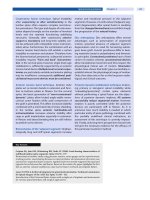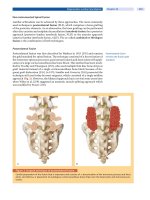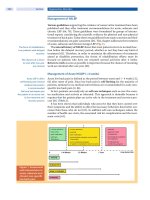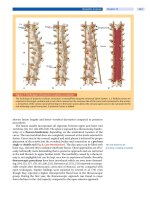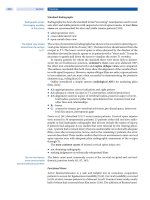Chapter 061. Disorders of Granulocytes and Monocytes (Part 10) potx
Bạn đang xem bản rút gọn của tài liệu. Xem và tải ngay bản đầy đủ của tài liệu tại đây (80.25 KB, 6 trang )
Chapter 061. Disorders of Granulocytes
and Monocytes
(Part 10)
Disorders of the Mononuclear Phagocyte System
Many disorders of neutrophils extend to mononuclear phagocytes. Thus,
drugs that suppress neutrophil production in the bone marrow can cause
monocytopenia. Transient monocytopenia occurs after stress or glucocorticoid
administration. Monocytosis is associated with tuberculosis, brucellosis, subacute
bacterial endocarditis, Rocky Mountain spotted fever, malaria, and visceral
leishmaniasis (kala azar). Monocytosis also occurs with malignancies, leukemias,
myeloproliferative syndromes, hemolytic anemias, chronic idiopathic
neutropenias, and granulomatous diseases such as sarcoidosis, regional enteritis,
and some collagen vascular diseases. Patients with LAD, hyperimmunoglobulin
E–recurrent infection (Job's) syndrome, CHS, and CGD all have defects in the
mononuclear phagocyte system.
Monocyte cytokine production or response is impaired in some patients
with disseminated nontuberculous mycobacterial infection who are not infected
with HIV. Genetic defects in the pathways regulated by IFN-γ and IL-12 lead to
impaired killing of intracellular bacteria, mycobacteria, salmonellae, and certain
viruses (Fig. 61-10).
Figure 61-10
Lymphocyte-macrophage interactions underlying resistance to
mycobacteria and other intracellular parasites such as Salmonella. Mycobacteria
infect macrophages, leading to the production of IL-12, which activates T or NK
cells through its receptor, leading to production of IL-2 and IFN-γ. IFN-γ acts
through its receptor on macrophages to upregulate TNF-α and IL-12 and kill
intracellular parasites. Mutant forms of the cytokines and receptors shown in large
type have been found in severe cases of nontuberculous mycobacterial infection
and salmonellosis.
Certain viral infections impair mononuclear phagocyte function. For
example, influenza virus infection causes abnormal monocyte chemotaxis.
Mononuclear phagocytes can be infected by HIV using CCR5, the chemokine
receptor that acts as a co-receptor with CD4 for HIV. T lymphocytes produce IFN-
γ, which induces FcR expression and phagocytosis and stimulates hydrogen
peroxide production by mononuclear phagocytes and neutrophils. In certain
diseases, such as AIDS, IFN-γ production may be deficient, while in other
diseases, such as T cell lymphomas, excessive release of IFN-γ may be associated
with erythrophagocytosis by splenic macrophages.
Autoinflammatory diseases are characterized by abnormal cytokine
regulation leading to excess inflammation in the absence of infection. These
diseases can mimic infectious or immunodeficient syndromes. Gain-of-function
mutations in the TNF-α receptor cause TNF-α receptor–associated periodic
syndrome (TRAPS), which is characterized by recurrent fever in the absence of
infection, due to persistent stimulation of the TNF-α receptor (Chap. 323).
Diseases with abnormal IL-1 regulation leading to fever include familial
Mediterranean fever due to mutations in pyrin. Mutations in cold-induced
autoinflammatory syndrome 1 lead to neonatal onset multisystem
autoinflammatory disease, familial cold urticaria, and Muckle-Wells syndrome.
Pyoderma gangrenosum, acne, and sterile pyogenic arthritis is caused by
mutations in CD2BP1. In contrast to these syndromes of overexpression of
proinflammatory cytokines, blockade of TNF-α by the antagonists infliximab,
etanercept, and adalimumab has been associated with severe infections due to
tuberculosis, nontuberculous mycobacteria, and fungi (Chap. 323).
Monocytopenia occurs with acute infections, with stress, and after
treatment with glucocorticoids. Monocytopenia also occurs in aplastic anemia,
hairy cell leukemia, acute myeloid leukemia, and as a direct result of myelotoxic
drugs.
Eosinophils
Eosinophils and neutrophils share similar morphology, many lysosomal
constituents, phagocytic capacity, and oxidative metabolism. Eosinophils express
a specific chemoattractant receptor and respond to a specific chemokine, eotaxin.
Little is known about the role of eosinophils. Eosinophils are much longer lived
than neutrophils, and unlike neutrophils, tissue eosinophils can recirculate. During
most infections, eosinophils are not important. However, in invasive helminthic
infections, such as hookworm, schistosomiasis, strongyloidiasis, toxocariasis,
trichinosis, filariasis, echinococcosis, and cysticercosis, the eosinophil plays a
central role in host defense. Eosinophils are associated with bronchial asthma,
cutaneous allergic reactions, and other hypersensitivity states.
The distinctive feature of the red-staining (Wright's stain) eosinophil
granule is its crystalline core consisting of an arginine-rich protein (major basic
protein) with histaminase activity, important in host defense against parasites.
Eosinophil granules also contain a unique eosinophil peroxidase that catalyzes the
oxidation of many substances by hydrogen peroxide and may facilitate killing of
microorganisms.
Eosinophil peroxidase, in the presence of hydrogen peroxide and halide,
initiates mast cell secretion in vitro and thereby promotes inflammation.
Eosinophils contain cationic proteins, some of which bind to heparin and reduce
its anticoagulant activity. Eosinophil-derived neurotoxin and eosinophil cationic
protein are ribonucleases that can kill respiratory syncytial virus. Eosinophil
cytoplasm contains Charcot-Leyden crystal protein, a hexagonal bipyramidal
crystal first observed in a patient with leukemia and then in sputum of patients
with asthma; this protein is lysophospholipase and may function to detoxify
certain lysophospholipids.
Several factors enhance the eosinophil's function in host defense. T cell–
derived factors enhance the ability of eosinophils to kill parasites. Mast cell–
derived eosinophil chemotactic factor of anaphylaxis (ECFa) increases the number
of eosinophil complement receptors and enhances eosinophil killing of parasites.
Eosinophil CSFs (e.g., IL-5) produced by macrophages increase eosinophil
production in the bone marrow and activate eosinophils to kill parasites.


